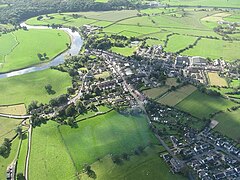Ribchester
| Ribchester | |
|---|---|
 Aerial view of Ribchester |
|
| Ribchester shown within Lancashire | |
| Population | 1,598 (2011) |
| OS grid reference | SD649353 |
| Civil parish |
|
| District | |
| Shire county | |
| Region | |
| Country | England |
| Sovereign state | United Kingdom |
| Post town | PRESTON |
| Postcode district | PR3 |
| Dialling code | 01254 |
| Police | Lancashire |
| Fire | Lancashire |
| Ambulance | North West |
| EU Parliament | North West England |
| UK Parliament | |
Ribchester is a village and civil parish within the Ribble Valley district of Lancashire, England. It lies on the banks of the River Ribble, 6 miles (10 km) northwest of Blackburn and 12 miles (19 km) east of Preston.
The village has a long history with evidence of Bronze Age beginnings. It is well known as a significant Roman site being the location of a Roman cavalry fort called Bremetennacum, some parts of which have been exposed by excavation. In common with many towns and villages in East Lancashire its later history was dominated by cotton weaving; firstly in the form of hand-loom weaving and later in two mills. Neither mill still operates and the village is primarily a dormitory village for commuters to the town of Blackburn and the cities of Preston and Manchester.
The main access road into Ribchester is the B6245. From the north-west, this is Preston Road, which merges into Church Street. From the east, it is Blackburn Road, which, at its westernmost extremity, also links up with Church Street, albeit closer to the centre of the village. Stonygate Lane, which runs to the north, partially follows the route of the old roman road into Ribchester.
The earliest evidence of occupation in Ribchester is from the Bronze Age.
The village was originally established as a Roman auxiliary fort named Bremetennacum or Bremetenacum Veteranorum. The first fort was built in timber in AD 72/73 by the 20th legion. The fort was renovated in the late 1st century AD and was rebuilt in stone in the early 2nd century. During the life of the fort, a village grew up around it. A fort remained at Ribchester until the 4th century AD and its remains can still be seen around the present village.
A report on Roman remains at Ribchester was published in Roman Britain in 1914 (Haverfield, 1915):
...
Wikipedia

